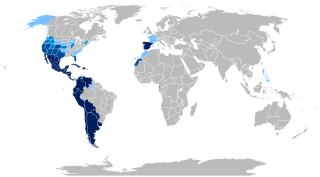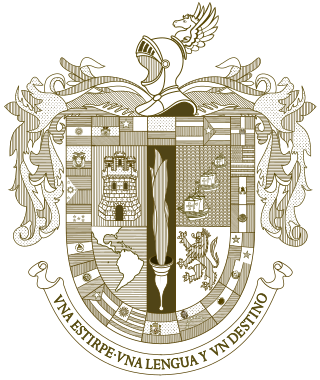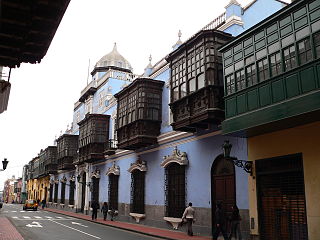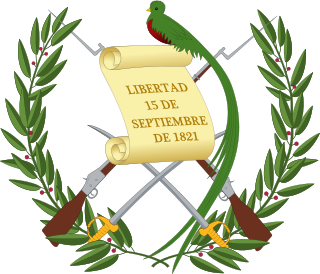
Spanish is a Romance language of the Indo-European language family that evolved from colloquial Latin spoken on the Iberian peninsula. Today, it is a global language with more than 500 million native speakers, mainly in the Americas and Spain. Spanish is the official language of 20 countries. It is the world's second-most spoken native language after Mandarin Chinese; the world's fourth-most spoken language overall after English, Mandarin Chinese, and Hindustani (Hindi-Urdu); and the world's most widely spoken Romance language. The largest population of native speakers is in Mexico.

The Royal Spanish Academy is Spain's official royal institution with a mission to ensure the stability of the Spanish language. It is based in Madrid, Spain, and is affiliated with national language academies in 22 other Hispanophone nations through the Association of Academies of the Spanish Language. The RAE's emblem is a fiery crucible, and its motto is Limpia, fija y da esplendor.

The Association of Academies of the Spanish Language is an entity whose end is to work for the unity, integrity, and growth of the Spanish language. It was created in Mexico in 1951 and represents the union of all the separate academies in the Spanish-speaking world. The association publishes reference works on the Spanish language and commemorative editions of Hispanic literature, among other publications.
The Third International Congress of the Spanish Language was a cultural event that took place in Rosario, Argentina, on November 17-19, 2004.
The Philippine Academy of the Spanish Language is the language regulator for the Spanish language in the Philippines. It is one of two Spanish language regulators located in countries where the language does not have an official status nationwide, the other being the North American Academy of the Spanish Language in the United States.

The Diccionario de la lengua española, previously known as Diccionario de la Real Academia Española, is produced, edited, and published by the Royal Spanish Academy (RAE) with participation of the Association of Academies of the Spanish Language. It was first published in 1780, and subsequent editions have been published about once a decade. The twenty-third edition was published in 2014; it is available online, incorporating modifications to be included in the twenty-fourth print edition.
The Miguel Ángel Asturias National Prize in Literature is the most important literary award in Guatemala. Sometimes referred to as the "National Literary Prize", it is dedicated to the memory of the Guatemalan writer, statesman, and Nobel Prize winner Miguel Ángel Asturias and is a one-time only award that recognizes an individual writer's body of work.
The Academia Chilena de la Lengua is an association of academics and experts on the use of the Spanish language in Chile. It is a member of the Association of Academies of the Spanish Language and is a part of the Instituto de Chile.
The North American Academy of the Spanish Language is an institution made up of philologists of the Spanish language who live and work in the United States, including writers, poets, professors, educators and experts in the language itself. Its mission is to support and promote the study and correct usage of Spanish in the United States of America. The Academia, established in New York City in 1973, is a corresponding member of the Real Academia Española and a member of the Asociación de Academias de la Lengua Española, in Madrid, Spain.
The Academia Dominicana de la Lengua is the Dominican Republic's correspondent academy of the Royal Spanish Academy. It was founded in Santo Domingo on 12 October 1927 and, like the other academies, has the principal function of working to regulate the Spanish language.

The Academia Colombiana de la Lengua is an association of academics and experts on the use of the Spanish language in Colombia. It is based in Bogotá, Colombia's capital, and is a member of the Association of Spanish Language Academies.

The Peruvian Academy of Language is an association of academics and experts on the use of the Spanish language in Peru. It was founded in Lima on May 5, 1887. Its first elected president was Francisco García Calderón. The second president was Ricardo Palma. It is a member of the Association of Spanish Language Academies.
The Academia Costarricense de la Lengua is an association of academics and experts on the use of the Spanish language in Costa Rica. It was founded in San José on October 12, 1923. It is a member of the Association of Spanish Language Academies.
The Diccionario panhispánico de dudas or DPD is an elaborate work undertaken by the Real Academia Española and the Association of Spanish Language Academies with the goal of resolving questions related to the proper use of the Spanish language. Like other publications of the academy, such as the Diccionario de la lengua española de la Real Academia Española, the work follows a linguistically prescriptive philosophy as opposed to a descriptive one. The first edition was published in 2005 and is now being revised to more properly align with principles set forth by the academy's other publications.
Events in the year 1959 in Mexico.

Margarita Carrera Molina was a Guatemalan philosopher, professor and writer. She was a member of the Academia Guatemalteca de la Lengua and the 1996 laureate of the Miguel Ángel Asturias National Prize in Literature.

Luz Méndez de la Vega was a Guatemalan feminist writer, journalist, poet, academic and actress. As an academic, she concentrated on researching and rescuing the work of colonial Guatemalan women writers. She was the winner of Guatemala's highest prize for literature, Miguel Ángel Asturias National Literature Prize, and the Chilean Pablo Neruda Medal, among many other literary awards throughout her career.

Próspero Morales was a Guatemalan lawyer who served as Secretary of Infrastructure, War and Public Instruction during José María Reina Barrios administration. Two year after being in office, Morales married the well known Guatemalan teacher Natalia Górriz. Morales resigned as Secretary on 5 March 1897 in order to run for president for the upcoming presidential elections; however, due to the failure of the Exposición Centroamericana and the severe economic crisis that Guatemala was undergoing at the time, due to the plummeting of coffee and silver international prices, general Reina Barrios suspended the elections and forcibly extended his tenure until 1902. Morales then joined the revolution that was brewing in Quetzaltenango, but the rebels were defeated on 14 September 1897. After Reina Barrios assassination on 8 February 1898, he unsuccessfully tried to overthrow interim president Manuel Estrada Cabrera–who also had served as Secretary under Reina Barrios–but was repelled by the forces of former president Manuel Lisandro Barillas.

This is a list of foreign ministers of Guatemala from 1945 to the present day.
The order of precedence in Guatemala is a symbolic hierarchy of officials used to direct protocol. It is regulated by Presidential Decree 07-2003 of March 11, 2003. signed by then President Alfonso Portillo, President of the Congress Efraín Ríos Montt and Former Interior Minister José Adolfo Reyes Calderón.










